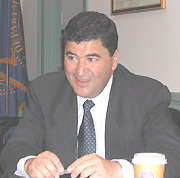
| T H E N I H C A T A L Y S T | J A N U A R Y – F E B R U A R Y 2003 |
|
|
|
ELIAS ZERHOUNI: LIVING IN INTERESTING TIMES |
by Fran
Pollner |
 |
|
Elias
Zerhouni
|
Sixteen-hour workdays have been the norm for Elias Zerhouni since he relocated last May from the Johns Hopkins University School of Medicine to Building 1 on the NIH Bethesda campus. "I have never worked harder in my life," he told The NIH Catalyst in an interview in early December, a little more than six months into his incumbency as NIH director.
Zerhouni arrived at NIH at a time when the institutes were riddled with vacancies and the national and international significance of biomedical research had become even more prominent against the backdrop of potential bioterrorism.
Since his arrival, he has appointed two new institute directors—Thomas Insel at NIMH and Ting-Kai Li at NIAAA—and he says that additional announcements are imminent. He has also become nearly as familiar with the halls of Congress and the offices of the executive as with the lecture halls and labs of NIH.
Q: How’s the job so far? Any surprises?
Zerhouni: It’s pretty good.
It’s working 16 hours a day, every day, but in looking at the past six to seven months that I’ve been here, I’m amazed at how much has been accomplished: We’ve had intense brainstorming sessions and a retreat with the directors; we’ve outlined priorities and initiatives for NIH research; we’ve recruited new directors.
As for surprises, the biggest surprise is the complexity of it. There are so many constituencies, and the job is very public—before, I had to scream to be heard; now anything I whisper becomes big news. You have to readjust.
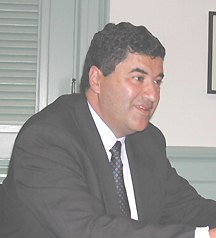 |
|
Any
high-profile agency that receives significant dollars will be questioned
about whether those dollars are well used . . . .
|
But it’s the complexity of the inputs—inputs from the institutes, the scientific community, the Congress, the public—this job requires more breadth than I had expected. And the need for communications is much greater across the board than I had expected. I’ve learned a lot in talking to many of the constituencies.
Q: What seem to be the chief concerns of the constituencies?
ZERHOUNI: Everyone wants to be re assured that NIH has its act together. The chief concern is that now that we’ve doubled the NIH budget, is the NIH being true to its mission, is it delivering to the American people? I’ve been asked why the number of grants has not doubled, whether the new buildings are really necessary.
Any high-profile federal agency that receives significant dollars will be questioned about whether those dollars are well used—and some people will think they are and some will not.
Q: Will our construction plans present a political problem?
ZERHOUNI: No, I don’t think so.
Q: What’s your assessment of the intramural research program?
Zerhouni: The intramural program is the most impressive biomedical research program in the world by virtue of its size, complexity, and the breadth of its endeavors.
What’s really important to me is that the research conducted by the intramural program—because it is not subject to renewed competitive peer review—has to be second to none and should fulfill a unique mission. It should do those things that are truly inaccessible to extramural institutions, things the nation needs done that neither industry nor academia can do. A good example is vaccine research. Intramural research should break new ground. The Clinical Center should define itself as the only place in the country where truly groundbreaking clinical research can be done.
Q: Do you think NIH research lives up to these criteria?
ZERHOUNI: So far, from what I can tell, there’s quite a bit of outstanding work being done in the intramural program. I don’t know enough yet of all the details to say that every part of the program is groundbreaking, that everything has been looked at by the intramural community in terms of its being innovative, creative, and risk taking. We have not yet done a formal, across-the-board analysis—that first level of analysis—to define unique research opportunities or major roadblocks that cannot be addressed elsewhere.
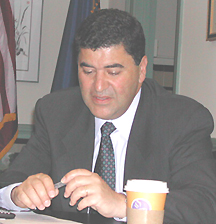 |
|
We
made clear that . . . the country was well served by what we’d created.
There will be a need to coordinate and consult with the Department of
Homeland Security–that’s what NIH is all about–but I am
not aware of any movement of people . . . .
|
I am impressed by the scientific directors, by their commitment to innovation. Their collegiality and core values and spirit—an NIH spirit—are very strong, and they are committed to sustaining the worldwide leadership of the intramural program as research paradigms change. NIH has a major role to play in advancing methodologies for research—discoveries in structural biology; the study of molecular complexes, which no one really knows how to do; the study of membrane-bound proteins—all the issues that relate to what I call mathematical biology.
Q: Is the national focus on bioterror-related research relegating other NIH research to places of lesser importance and funding? How does the creation of the Department of Homeland Security affect NIH research?
ZERHOUNI: One of the very first things on my agenda after I got here was this issue. Initially, it was presented that NIAID’s biodefense research program would go into homeland security, and we worked very hard over several months regarding this issue. During talks involving the administration, the Department [of Health and Human Services], [NIAID director] Tony Fauci, and myself, we made clear that we could not recreate all the scientific skill set established in NIAID and in the extramural community, and that the country was well served by what we’d created. There will be a need to coordinate and consult with the Department of Homeland Security—that’s what NIH is all about—but I am not aware of any movement of people or shifts in research resources.
As for the effect of funding on other NIH research, we’ve been given extra resources for biodefense research, so there should be no effect.
Q: With the advent of the current administration, there has been an emphasis on "one HHS." Do you think NIH has sufficient autonomy from the Department? Is there micromanagement of NIH operating procedures or censorship of NIH’s scientific voice?
ZERHOUNI: "One HHS" is the secretary’s strategy for coherence in health research policy and for the coordination that has been lacking in utility functions, such as e-mail systems and software for results reporting. "One HHS" is not a power play but a collaborative process so that services and functions can be shared throughout the Department. Iit’s an effort to use taxpayer money efficiently, to be accountable and transparent.
Decentralization is good for a knowledge enterprise like NIH. You cannot do research the same way you process bills, but we can have common approaches to common problems when it comes to utility functions. NIH is not a paradigm of efficient management. For instance, we could not report clinical research consistently across NIH—there was no consistent set of numbers to report to Congress because there weren’t common measures of clinical research activities among the institutes.
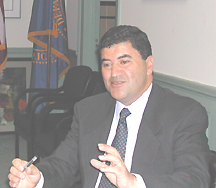 |
|
I
have not seen any censorship. I personally speak freely and will continue
to . . . .
|
Regarding scientific censorship, or "one scientific voice," I have not seen any censorship. I personally speak freely and will continue to, and that’s reflected in my public statements and testimony to Congress. Sometimes it is necessary to resent a central scientific voice in scientific communications: Take the example of the Women’s Health Initiative and the forum we held here [see "Disparate Voices Reflect on WHI Data," The NIH Catalyst, November–December 2002]—would it have been better to have NCI, NHLBI, and OD all do their own things? Or was coordination beneficial?
With respect to personal views, individual free speech and academic freedom are essential to a knowledge institution—and I stepped in to defend a scientist at NIEHS who felt his freedoms had been restricted. But one must be careful to present a personal view as just that and not pretend to be representing NIH or use the NIH title to promote one’s personal views.
Q: What about embryonic stem cell research?
ZERHOUNI: Let’s face it, before the president announced his policy, not one dime of the federal dollar was going into this research. It’s a golden opportunity for NIH leadership—as a training ground, as a resource center, as a setter of strategic priorities.
Any new science needs nurturing, and I immediately created a stem cell task force when I got here. We need to not get bogged down in rhetoric but to get down to work. There’s a lot we don’t know and must know before we can entertain approaches to regenerative medicine.
NIH needs to frame the issue in a factual way. And, really, NIH is the one institution in this country that can serve as the source of trusted information for the public of what is and is not fact, what is speculation and what is real—unfettered by political consideration—in this and all scientific research areas. If you’ve lost the public trust, you’ve lost everything. And that’s also one reason why you can’t have 10 sources of conflicting information.
I came to this job with one very simple view, and that is that disease knows no politics—and I try to make sure that all parties understand that, all sides of the debate understand that. And I have to say that I am impressed by the thoughtfulness of the House and Senate leadership and the high quality of the Congressional staff; the same is true within the administration.
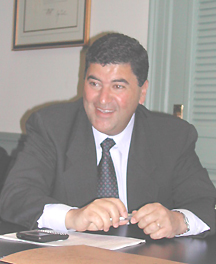 |
|
I
still have some ideas left . . . . image-guided microsurgery . . . . disease
preemption . . . .
|
By and large, I have not found the task of sending messages to the political constituencies to be daunting—so long as I have my facts. But the importance of that task is much more than I considered initially. It is a primary priority to be able to interact, educate, coordinate, and strategize to achieve continued understanding by all political parties.
NIH has a tough mission. In the entire scientific spectrum, it is the life sciences that are the grand challenge for now and the foreseeable future. We need to make discoveries at a more rapid pace because time is of the essence when you consider the aging of the population, the growth of our health expenditures, and the new threats that are emerging. We need to accelerate our knowledge base in the life sciences. That is the perspective I try to bring to the political constituencies.
Q: In the scheme of things of apportioning your time as NIH director, do you miss doing clinical radiology?
ZERHOUNI: Not really. I do like to consult on the tough cases—that’s what I did before—but right now I’m so totally focused on my job. My philosophy is that it’s better to spend 100 percent of your time on your priority early on than 10 percent each on 10 different things because at the end of the day you will not have accomplished anything. But I do want to get back to some imaging research at some point.
Q: Will you do that here?
ZERHOUNI: I hope so. I still have some ideas left.
Q: What are they?
ZERHOUNI: Well, my primary research has been on using quantitative approaches—mathematics, computation—to nhance the basic process of image acquisition to better diagnose and treat disease. Now, of course, quantitative analysis is the standard method, but let me tell you that my early papers—on measuring the intrinsic absorption of X-rays in lesions, on different calcium concentrations in tumors—generated years of controversy.
One submitted paper generated 26 different criticisms needing to be addressed before it could be published. People thought it was too expensive, and there was inherent opposition to the idea of not operating surgically, even though two-thirds of the operations were for benign lesions. (In my experience, any really groundbreaking paper had difficulty being accepted, while the mundane sailed through.)
We need another quantum jump of imaging in medicine. I envision that in 30 to 40 years there will be no open surgery. Traditional surgery will disappear, as will traditional anesthesia, and there will be only image-guided microsurgery. We’re headed in that direction now.
Disease preemption is another research area that I’m hoping to do work in. It involves image guidance and the interaction of energy and biological molecules to put specific cell populations at rest and prevent them from becoming malignant. Breast cancer, for example, arises from less than 1 percent of mammary cells. Why could we not, around the time of menopause, put cells in a quiescent state to prevent the genetic cascade of events that result in breast cancer? Even moderate success would change the incidence of disease.
The concept of preemption
has not been explored, and, obviously, this approach has wider applications.
This is what I’m hoping to do.
![]()
| ROADBLOCKS, ROAD MAPS, AND THE 'PERFECT STORM' |
|
Immediately after talking to The NIH Catalyst, NIH Director Elias Zerhouni sat down with the heads of NIH’s Boards of Scientific Counselors (BSC)—the outside panels that critically review NIH intramural investigators every four years. Offering "the bad news" first, Zerhouni opened with his apprehensions about NIH funding and likened the fiscal environment to "a ‘Perfect Storm’ scenario." Ominous converging forces include the U.S. government’s going from fiscal surpluses to deficits, a teetering economy, support for a new Department of Homeland Security, other post-9/11 security measures, the war on terrorism, and the possibility of war in Iraq—all transpiring at the moment NIH was to receive the final installment of its promised five-year budget doubling. With NIH operating under a continuing resolution at least into January, Zerhouni said it was not clear when and at what levels NIH’s 2003 budget would be approved. A self-avowed optimist, however, he said President Bush was committed to the need for doubling NIH’s budget. "At the end of the day, it will go forward. We should do well, but it is not that predictable." He observed that there are probably thicker clouds gathering over the 2004 budget, the year NIH was to attempt a "soft landing" after the years of increase. At the BSC meeting, Michael Gottesman, deputy director for intramural research, clarified that a doubling of the NIH budget has not and will not mean a doubling of the intramural research budget. Although there has been an increase in dollars going to intramural research, overall the intramural program has declined as a percentage of the NIH budget from 11.2 percent in 1993 to 9.6 percent in 2002. On a brighter note, Zerhouni told the BSC chairs about his efforts to identify key roadblocks to the advancement of biomedical research and to plot a map that will guide research to achieve the progress that taxpayers and legislators expect after doubling NIH’s budget. Zerhouni said that he had brought to NIH more than 100 scientists to help him over the summer with his quest for a road map. He made a more formal presentation of the roadblocks and road maps when he met with his Advisory Committee to Director (ACD) on December 5. Citing dramatic changes in the biomedical research enterprise, the experts stressed the overwhelming amounts of data that are emerging—much of it poorly understood. With extraordinary technology driving the process, some individual laboratories are now churning out results that in their complexity, scope, and scale could match what an entire institute might have produced 10 or 20 years ago. Often the data are within NIH’s purview but cross traditional institute lines. High-risk, longer-term studies with potentially large payoffs present the greatest challenges. Key areas where NIH has a role are in the development of revolutionary technology and novel methods of research, including robotics, nanotechnology, DNA array technology refinement, reagents, 3-D protein structures, models of protein-protein interactions, molecular libraries (going beyond cDNA databases) that can be interrogated, and bioinformatics methods for resolving the fog of data emanating from labs across the country. "The scale-up of data generation has been intense," Zerhouni said, "but we have not developed the ability to resolve the data on a temporal or spatial level sufficient to make models, such as of membrane-bound proteins, for example." Speaking to the ACD, Zerhouni pointed out that membrane proteins may account for 30 percent of all biologically relevant molecules. NIH, Zerhouni said, is being called on to develop these technologies and then make them available to biomedical researchers. Also needed from NIH is a "pathways" view of research that avoids traditional reductionist views and encourages a multidisciplinary approach to explore entirely new avenues of investigation. At the ACD meeting, he emphasized the need to assemble teams of scientists who have cross-trained at least enough to talk to one another about common problems and approaches. He cited five ubiquitous concepts that stand out as areas for discovery: genomics and proteomics, cell signaling, apoptosis, cell trafficking, and cell cycle control. Needs are particularly acute for clinical research, Zerhouni said, where NIH should define unifying standards that would allow data to be readily extracted, recombined, exchanged, and probed in creative ways. Currently, multiple medical dictionaries and definitions of diseases prevent correlations between different studies, greatly restricting their power. Even the largest individual studies, such as the Women’s Health Initiative (see "Disparate Voices Reflect on WHI Data," The NIH Catalyst, November–December 2002) cannot possibly answer all the questions in and of themselves. NIH is the only entity that can step into such areas, Zerhouni said. "We have a role to play." |